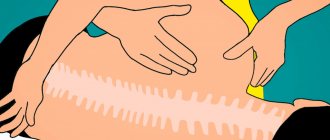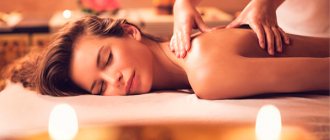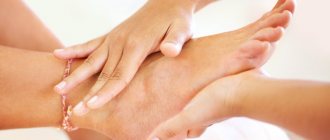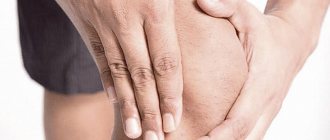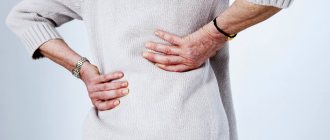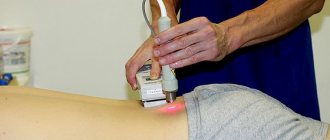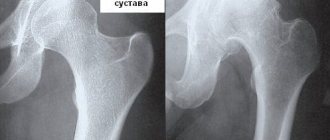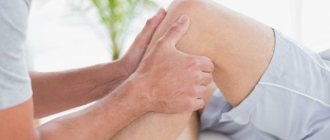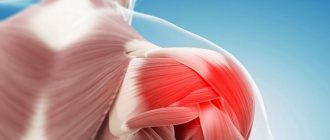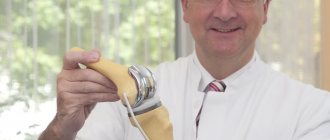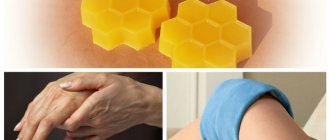Author
: Grachev Ilya Illarionovich
Editor
: Efremov Mikhail Mikhailovich
Publication date: 05/13/2014 Update date: 10/02/2017 All doctors of the clinic
General massage is a set of techniques for targeted mechanical and reflex effects on certain areas of the body through stroking, rubbing, pressing and vibration. The use of the technique by specialists at the Paramita clinic has a therapeutic effect, allows you to acquire attractive shapes and receive a charge of positive energy. The method is aimed at relaxing the nervous system, restoring strength, reducing general tension, and eliminating chronic pain syndromes.
Massage for joint diseases
Massage is indicated for rheumatoid arthritis, other inflammatory processes of the joints, arthrosis, and after injuries. It helps with joint pain as it reduces tissue swelling and improves microcirculation. Massage promotes the release of inflammatory products that irritate nerve endings and cause pain.
Most often, massage procedures are not used without the use of other therapeutic measures. This is just one element of conservative therapy. Along with massage, the following are used:
Effects of classic massage
Stimulation of nerve endings, muscles, blood vessels allows you to achieve many positive effects:
- normalization of muscle tone;
- restoration of normal elasticity of tissues - ligaments, muscles, tendons;
- elimination of cramps and muscle spasms;
- increasing the overall tone of the body;
- normalization of blood circulation and lymph flow;
- relaxation after stress, positive psycho-emotional effect;
- restoration of body contours and reduction of subcutaneous fat volume;
- reduction of swelling;
- strengthening the muscle corset;
- improving the mobility of joints and vertebrae, restoring normal range of motion.
Thanks to a general classical massage, it is possible to speed up recovery and recovery from injuries, improve the body’s own defenses, relieve tension, and get rid of chronic pain and dizziness.
The positive effect of massage on the skin is known: it is cleansed of dead cells, moisturized, and becomes more elastic and firm. The protective properties of the skin and resistance to infectious agents and allergens increase.
When combining massage with other therapeutic methods, it is possible to achieve impressive results, speed up recovery and tissue regeneration. Massage can be supplemented with physical therapy, visiting the pool, diet therapy, and medication methods for treating many diseases.
Massage for joint diseases
Massage for joint diseases
- physiotherapy;
- physiotherapy;
- kinesio taping;
- immobilization of the injured limb;
- medical supplies;
- intra-articular injections.
Massage helps increase the safety of physical exercise. By warming up the muscles and joints before training, a person is much less likely to sprain a ligament or suffer a muscle injury.
When is it time to see a massage therapist?
For static and sedentary work:
- Pain in the back, lower back, neck
- Chronic fatigue
- Dizziness
- Nervousness
- Distracted attention
In case of injuries and mechanical damage:
- Fractures and dislocations
- Joint stiffness
- Muscle changes
- Scar tissue adhesions
- Bruises, sprains of muscles, tendons and ligaments
For diseases of the nervous and cardiovascular systems:
- Pain in the back, lower back, neck
- Arthritis and arthrosis in subacute and chronic stages
- Scoliosis and kyphosis
- Flat feet
For metabolic disorders:
- Obesity
- Diabetes
- Shortness of breath
- Cellulite
- Orange Peel Syndrome
When playing sports:
- Muscle strain
- Hypoxia
- Pain syndrome
- Adhesions and fibrosis as a result of microtraumas
- Constant fatigue as a result of training
Leg joint massage
Massage effects on any joints of the lower extremities are contraindicated before examination in case of acute pain. It is important to make sure before starting treatment that there are no broken bones, dislocations, complete ligament ruptures or other serious injuries.
Basically, massage is done a few days after the acute pathological process has subsided (after injury, acute inflammation), as well as for chronic pain in the knee, hip, ankle or other joint. Procedures are carried out every day. Sometimes 2 massage sessions per day are required.
The technique may vary significantly, depending on the location of the pathology, its severity, and the cause of pain in the joint. But the general algorithm is approximately the same:
Contraindications
- Acute skin diseases and allergic rashes
- Presence of malignant tumors
- Inflammation of bone tissue
- Purulent processes regardless of location
- Inflammatory processes, elevated body temperature
- The body's tendency to form bleeding and blood clots
- AIDS, sexually transmitted diseases
- Alcohol and drug intoxication
- Mental illnesses with increased excitability of the nervous system
Results of treatment with general massage
- The body is completely relaxed and has a tonic effect
- Blood circulation is restored and immunity is improved
- Improves mood
- Relieves fatigue and restores performance
- Improves health and reduces the risk of colds and infectious diseases
Leg joint massage
Leg joint massage
- start the massage with stroking;
- then make kneading movements;
- the muscles located near the lesion are affected;
- the source of pain itself is not massaged;
- any movements should be painless, and if they provoke pain, the massage therapist reduces the intensity of the impact or works on areas that are more distant from the source of pain.
It is better not to touch the joint itself if it is severely swollen, deformed, or there are signs of hematoma or significant instability. But you can massage the muscles near the problem joint to improve blood circulation, reduce swelling and provide good conditions for regenerative processes.
Prices per session
Sports massage RUR 3,000.60 min. Cupping massage, 1 zone RUR 1,490. 20 min.
| General back massage | 3000 rub. | 60 min. |
| General massage (full body) | 4500 rub. | 90-120 min. |
| Massage of one zone (cervical-collar, thoracic, lumbosacral) | 1490 rub. | 20 minutes. |
| Massage of one area (neck-collar, face, décolleté, head) | 2500 rub. | 45 min. |
| Lymphatic drainage massage (full body) | 3000 rub. | 60 min. |
| Hemolymphatic drainage massage (whole body) | 5000 rub. | 90 min. |
| Anti-cellulite massage (abdomen, thighs, buttocks) | 3000 rub. | 50 min. |
| Anti-cellulite massage (thighs, buttocks) | 2500 rub. | 40 min. |
| Anti-cellulite massage (stomach, sides) | 2000 rub. | 30 min. |
| Foot massage (feet, shins) | 2000 rub. | 30 min. |
| Hand massage | 1500 rub. | 20 minutes. |
| Anti-stress massage, whole body | 3000 rub. | 60 min. |
| Anti-stress massage, 1 zone | 1000 rub. | 15 minutes. |
| Back massage using osteopathic techniques | 1000 rub. | 15 minutes. |
| Back massage using osteopathic techniques | 2000 rub. | 30 min. |
| Back massage using osteopathic techniques | 3000 rub. | 60 min. |
| Massage (together with doctors) | 1000 rub. | 15 minutes. |
Hand massage for joint pain
You can massage any part of the body, including your hands. The joints of the upper extremities hurt much less frequently than the lower ones. Degenerative processes do not develop here so often. But pain is still possible, especially with rheumatic pathologies, as well as against the background of constant heavy physical exertion. Shoulder diseases are not uncommon. They are especially common among representatives of professions who are forced to make the same movements in the shoulder for a long time. These are painters, builders, artists, surgeons, etc.
If your hands hurt due to physical activity, the only effective method of non-surgical treatment is functional rest. It is imperative to eliminate the main pathogenetic factor that leads to pain. You should either reconsider occupational hygiene or change your job altogether. In addition, during the treatment period, the suspension of professional activities that led to pain is required.
Hand massage for joint pain
Hand massage for joint pain
Massage can be used for almost any disease of the hand joints. Its benefits include reducing pain and eliminating swelling. The procedure has virtually no effect on the outcome of the disease. But it allows you to reduce the main symptoms and quickly stop taking painkillers.
A feature of massage for rheumatic diseases is the absence of vigorous rubbing, as this can lead to an increase in the amount of intra-articular effusion. Chopping, beating and squeezing are also not done.
Classic massage techniques
A classic massage session involves working only with the hands of a specialist. He can use the following techniques and techniques:
- stroking. This is the beginning of the session, it is important to prepare the tissues for deeper treatment and relax the muscles. The technique is designed to reduce pain, relax muscles and achieve the desired psycho-emotional state, increase tissue elasticity;
- trituration. This technique is necessary to improve blood supply to the treated area. It allows you to improve the outflow of lymph and stimulate rapid recovery. Demonstrates good results in cases of trauma, neuralgia, radiculitis;
- kneading. Represents gentle squeezing, pulling, and grasping of the skin. The intake effectively copes with swelling and congestion, stimulates regeneration by increasing the flow of oxygen and nutrients. You can call this technique passive gymnastics for the muscles;
- vibration. Oscillatory movements of different amplitudes: chopping, tapping, patting. The techniques are designed to stimulate the neuromuscular system, strengthen reflexes, and are used for various sensitivity disorders.
Classic medical massage does not imply ready-made solutions and schemes - a set of techniques and techniques is determined by a specialist taking into account the patient’s diagnosis, his condition, complaints, and concomitant diseases. Some techniques require repetition up to 4-5 times to obtain the desired result. The course can include up to 10–15 sessions, their number and duration (from 30 to 90 minutes) are determined individually.
Massage during rehabilitation
Massage is widely used in rehabilitation. It is given to patients after injuries and surgical operations. The purpose of massage is:
- reduction of symptoms;
- improved joint function, increased range of motion;
- preparing the limb for physical exercise;
- improving blood circulation and eliminating swelling;
- normalization of microcirculation and improvement of regenerative processes in soft tissues.
The massage can be started at different times. When deciding when to start this type of treatment, the patient's feelings should be taken into account. Massage should not cause pain. Therefore, if the pressure on the tissue is painful, only light stroking is allowed. If it also provokes pain, you should postpone the procedure, or perform a massage effect on the tissues located nearby. For example, in the early period of rehabilitation after knee surgery, it is not the knee joint itself that is massaged, but the thigh.
Preparation for massage and procedure progress
It is advisable to take with you to the massage therapist extracts and conclusions with updated diagnoses, if any, and it is also important to talk about your state of health, general well-being, complaints and symptoms. Immediately before the massage you need to take a shower. There is no need to apply cosmetics to the skin - the specialist uses hypoallergenic oils or gels to make it easier for hands to glide over the skin.
The procedure involves working on the entire body. The massage therapist begins to work from the cervical-collar area, gradually moving to the back, arms, buttocks, and lower extremities. The sequence of movements of the specialist corresponds to the flow of lymphatic fluid, which allows you to get a quick result. Techniques and techniques alternate with each other in a certain order; pre-warming of the tissues with soft, slow movements is mandatory.
The session includes four stages:
- preparatory. Warming up the muscles to improve blood flow, increase tissue elasticity, and increases the susceptibility of muscles to therapeutic effects;
- mid-depth. The massage therapist prepares the muscles at the average depth of the muscles, allowing them to normalize metabolic processes and motor function;
- deep stage. The specialist’s efforts become more pronounced; the lower layers of muscle tissue, which are responsible for maintaining the anatomically correct position of the spine, limbs, and joints, are worked out. This is the longest stage;
- The final stage. The techniques and methods are designed to relax the muscles that have been subjected to tonic and warming actions.
If you have suffered an injury, a disease of one or another part of the spine, or a disease of the joint/limb, you can resort to a local method of healing massage. For example, work only with the upper limbs, lumbar back, etc.
One of the types of medical massage that involves working with the back, cervical-collar area, and lumbosacral region is gentle muscle traction. It is used for curvatures of the spinal column.
